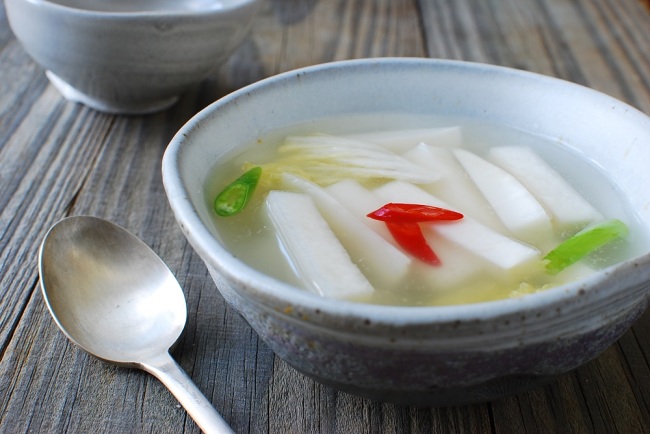
Dongchimi (Korean Bapsang)
Dongchimi is a mild water-based kimchi made with a small variety of white radish, called dongchimi mu. Traditionally, dongchimi is made with whole radishes and therefore takes weeks to mature. This recipe is a quick version. The radishes are cut into small pieces for quick salting and maturing. Within two days at room temperature, you’ll see bubbles rising through the brine which is a sign of active fermentation. During fermentation, healthy bacteria, acidity and sweetness develop, producing a tangy, refreshing broth with perfectly pickled radish.
Due to a digestive enzyme (diastase) that is plentiful in radishes, this kimchi promotes digestion, which is why it pairs especially well with meat dishes or starch-heavy foods such as rice cakes.
Ingredients:
● 1 kilogram mu (white radish)
● 2 tablespoons coarse sea salt (less if using table salt)
● 1 tablespoon sugar
● 200 grams napa cabbage (tender inner parts)
● 1 tablespoon coarse sea salt
● 2 green and/or red chili peppers, thinly sliced
● 2 scallions, cut into about 2.6-cm lengths
● 1 small Asian pear or apple, peeled and cored
● 5-6 plump garlic cloves
● 2-centimeter ginger piece
● 1/4 small onion
● 1 tablespoon glutinous rice powder
● 10 cups water
● About 2 tablespoons sea salt (If using table salt, use much less)
● 4-liter jar or airtight container
Cut each leaf of the cabbage into about 5 cm by 2 cm pieces. Dissolve the salt in 1 cup of water, and pour over the cabbage. Toss the cabbage pieces to coat well with the salt water. Let sit for a couple of hours until softened, rotating the bottom ones to the top midway through the process. Rinse and drain.
Clean the radishes by scrubbing with a brush and/or scratching off the impurities with a small knife. Do not peel the skin.
Cut each radish crosswise into about 5-cm logs. Cut each log (cut side down) into about 2-centimeter-thick pieces and then cut the pieces into about 2-centimeter-thick sticks. Place the radish pieces in a large bowl.
Sprinkle the salt and sugar over the radishes and toss well to coat evenly. Let sit for about 30-40 minutes until the radish sticks have softened and released some liquid. Drain, saving the liquid to add to the brine later. Do not rinse.
Whisk together the glutinous rice powder and 1 cup of water. Simmer over low heat, stirring occasionally, until it thickens into a thin paste, and then cool.
Place the pear (or apple), garlic, ginger and optional onion into the blender. Add 1/2 cup water. Puree mixture as finely as possible. If desired, run it through a fine strainer to remove any leftover solids.
To make the brine, add 9 cups of water to the liquid reserved from salting the radish. Stir in the salt, aromatic vegetable puree, and glutinous rice paste. Stir well to dissolve the salt. (Start with a smaller amount of salt and taste after stirring before adding more salt.)
Place the salted radish and cabbage in a jar or airtight container. Add the scallion and peppers. Pour the brine over, and stir everything well. Add more salt if necessary. If the brine is too salty, add more water to dilute. It should be a tad too salty to eat as is.
Leave it out at room temperature for a full day or two until bubbles rise through the brine. Taste again and adjust the salt level if necessary. Then, store in the fridge. Although you can start eating it any time at this point, it will need about a week or two in the fridge to fully develop the acidic, tangy flavors. It keeps well for several weeks in the fridge.
Stir from the bottom each time you ladle the broth from the jar or container to serve.
By Ro Hyo-sun
See more recipes at www.koreanbapsang.com.







